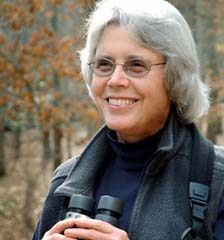Towhees Sing among Morning Glories, Goldenrod and Ragweed
The first two days of October have brought beautiful fall weather – with crisp, chilly mornings, deep blue sky, sparkling sunlight and brisk winds – and rather frustrating birding. The treetops have often seemed full of bird activity, but I haven’t been able to spot any migrants among the wind-tossed leaves, except for one Red-eyed Vireo.
Late this morning as I walked through the neighborhood, the kee-yer cry of a soaring Red-shouldered Hawk sounded clear and close, though the hawk was so high it was barely a speck against the blue. Four Chimney Swifts twittered much lower overhead. Phoebes, Pine Warblers and Mockingbirds sang, Brown-headed Nuthatches called squeaky-dee, and I heard the kleer! of a Northern Flicker – the first one I’ve heard this fall. Although some Flickers live here year-round, more usually arrive around this time to spend the winter here, so they become much more noticeable.
The Old Field that runs along the dead-end road just outside the entrance to our subdivision is coming alive with fall color and texture, despite the drought, and despite the fact that someone recently and pointlessly sprayed a lot of the already fading kudzu with an herbicide, turning it before its time into an ugly, scraggly brown mess. But goldenrod and other yellow-flowering weeds have begun to bloom in profusion. White, purple and pink morning glories wind through grasses and thorny weeds, and are especially pretty in a roadside ditch, where the blooms tumble over ragweed, horse nettles, and tough-looking brambles and vines. Sleepy orange and Cloudless Sulphur butterflies weave around foxtails, broomsedge, tall red-topped grasses, and the deep-purple berries and raw red stems of pokeweed. Now and then the burning-orange wings of a Gulf Fritillary dance like a small flame through the grasses. Grasshoppers sing and snap and fly.
The summer birds are gone from the field – indigo buntings, blue grosbeaks, white-eyed vireos, and I think even the catbirds now – and the winter sparrows and juncos haven’t yet arrived, so the mellow chewink of Eastern Towhees is the most characteristic call in the field right now.

0 Comments:
Post a Comment
<< Home